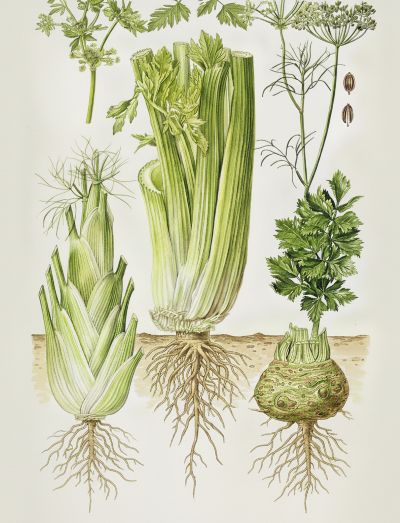Celery
Aromatic Celery
Apium graveolens L.
Family Umbelliferae — Apiaceae
Description of Celery
Aromatic celery is a biennial herbaceous plant, 0.6–1 m tall, with a thickened root and an erect stem. Leaves are pinnate, glossy, dark green, 3–6 cm. Flowers are small, white or greenish-white, gathered in compound umbels. Fruits are small achenes, 1–2 mm. Varieties: 'Pascal', 'Utah 52-70', 'Monarch', 'Giant Pascal' (stalk/stem celery); 'Safir', 'Brilliant' (celeriac/root celery); 'Par-Cel', 'Leaf Celery'. Flowering in July–August, fruiting in August–September. All parts of the plant have a characteristic spicy aroma.
Habitat and Ecology of Celery
Origin — Mediterranean. Cultivated in Russia, Ukraine, Belarus, Europe, North America, Asia. Prefers moist, fertile soils (pH 6.0–7.0), sunny areas, watering 15–20 l/m² every 5–7 days. Grows in fields, gardens, vegetable gardens. Propagates by seeds. Yield: 2–4 kg/m² (root celery), 1–3 kg/m² (stalk celery). Care: loosening, nitrogen fertilization (15–20 g/m²), protection from slugs, aphids.
Raw Materials from Celery
Raw materials: roots (radix Apii), stalks (petiolus Apii), leaves (folia Apii), seeds (semina Apii). Roots and stalks are harvested in September–October, dried at 40–50 °C (yield 10–15%). Leaves are harvested in June–August, dried at 30–40 °C (yield 15–20%). Seeds are harvested in August–September, dried at 35–40 °C (yield 20–25%). Quality: roots — light beige, stalks — green, seeds — grey-brown, moisture ≤12%. Store in airtight containers (roots, stalks: 1 year; leaves, seeds: 2 years). Spicy aroma, slightly bitter taste.
Chemical Composition of Celery
Roots and stalks: carbohydrates (up to 10%), proteins (up to 1.5%), vitamins (C up to 38 mg%, K, A, B1, B2), flavonoids (apiin), essential oils (0.1–0.3%), phthalides, minerals (K, Ca, Mg, P). Leaves: vitamin C (up to 100 mg%), essential oils (0.2–0.5%). Seeds: essential oils (up to 3%), coumarins, flavonoids. Calorie content: 16–40 kcal/100 g.
Action and Application of Celery
Celery has diuretic, anti-inflammatory, antioxidant, antispasmodic, and general tonic effects. It is used for hypertension, atherosclerosis, kidney diseases, bladder problems, rheumatism, gout, avitaminosis, metabolic disorders, obesity, gastritis with reduced acidity. Juice and infusions improve digestion and lower cholesterol levels. Leaves and seeds are used to treat nervous disorders and insomnia. Externally — for wounds, burns, skin inflammations.
Precautions for Celery Use
Consumption of >1 kg/day of fresh stalks or roots may cause diarrhea, stomach irritation. Juice (>100 ml/day) may increase skin photosensitivity. For children under 3 years — no more than 50 g/day. Seeds in large doses (>5 g/day) can be toxic due to essential oils. Wash raw materials thoroughly due to pesticides. Store juice at 0–5 °C for no more than 24 hours.
Contraindications for Celery Use
Hypotension, allergy to Apiaceae, gastritis with increased acidity, stomach ulcer, pregnancy (due to risk of uterine stimulation), lactation, epilepsy.
Recipes with Celery
- Juice for hypertension. Puree 100 g of stalks, strain, drink 30 ml twice a day, for 10 days.
- Seed infusion for gout. Pour 200 ml of boiling water over 2 g of seeds, let infuse for 30 minutes, drink 50 ml twice a day, for 7 days.
- Root decoction for constipation. Boil 20 g of roots in 200 ml of water for 15 minutes, drink 50 ml three times a day, for 5 days.
- Compresses for burns. Chop 50 g of leaves, apply for 20 minutes, rinse, twice a day, for 5 days.
- Celery Leaf Tea for Digestion. Steep a handful of fresh celery leaves in hot water for 5-10 minutes. Strain and drink.
- Celery Root Broth. Simmer chopped celery root with other root vegetables and herbs to make a flavorful and nutritious broth.
Celery in Cosmetics
Celery is used for skin care, reducing inflammation, and moisturizing.
- Mask for oily skin. 30 g of stalk pulp, 10 ml of lemon juice, apply for 15 minutes, rinse, twice a week.
- Lotion for acne. 20 ml of stalk juice, 10 ml of water, wipe the skin, once a day.
- Mask for hydration. 20 g of root pulp, 10 ml of honey, apply for 15 minutes, rinse, twice a week.
- Leaf infusion for hair. Pour 200 ml of boiling water over 15 g of leaves, let infuse for 20 minutes, rinse hair, once a week.
- Celery Seed Scrub. Mix finely ground celery seeds with a carrier oil (like jojoba) and gently exfoliate the skin.
Celery in Cooking
Stalks, roots, and leaves are used fresh, boiled, or dried in soups, salads, and side dishes.
- Salad. 100 g stalks, 50 g apples, 20 ml olive oil, 10 ml lemon juice, mix, serve fresh.
- Cream soup. 200 g roots, 100 g potatoes, 500 ml water, boil for 20 minutes, puree, add 20 ml cream.
- Juice. 200 g stalks, 100 g carrots, puree, strain, drink 100 ml once a day.
- Seasoning. Grind 50 g of dried leaves, mix with 10 g of salt, use for soups.
- Celery Stir-fry. Slice celery stalks and stir-fry with other vegetables and a protein for a quick and healthy meal.
- Roasted Celery Root. Peel and chop celery root, toss with olive oil, salt, and pepper, then roast until tender and slightly caramelized.
Tips: Store fresh stalks and roots at 0–5 °C for up to 1 month, dried — for up to 1 year. Wash raw materials thoroughly before cooking.
Other properties of celery
Used as a honey plant, in landscaping, for flavoring dishes and drinks.




